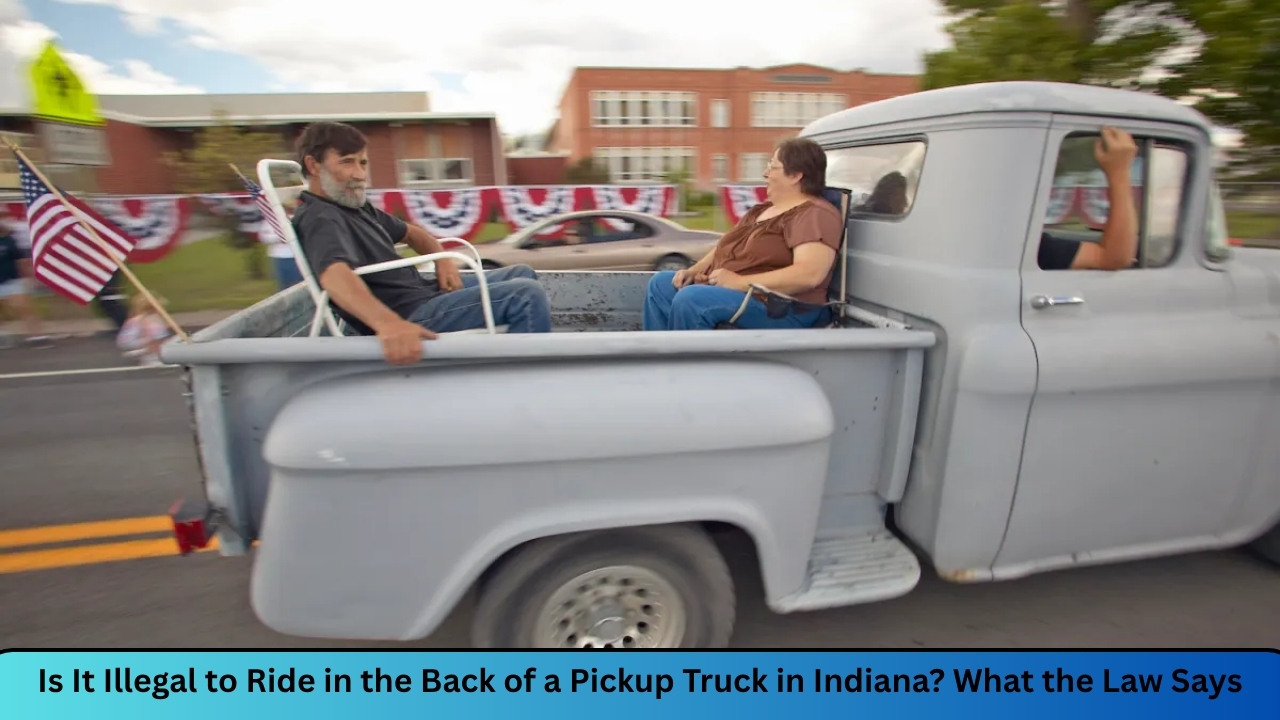The scene is a familiar one across the American heartland: a sunny day, a country road, and the wind whipping through the hair of passengers enjoying an open-air ride in the bed of a pickup truck. For many in Indiana, it’s a nostalgic picture, reminiscent of trips to the lake, helping out on the farm, or celebrating in a local parade. But behind this idyllic image lies a serious question: Is it actually legal to ride in the back of a pickup truck in Indiana?
The answer isn’t a simple yes or no. It’s a nuanced issue that balances personal freedom with public safety, governed by specific state statutes that every driver and passenger should understand. While it might seem like a harmless bit of fun, the laws—and the potential dangers—are significant. Before you or your loved ones hop into the cargo bed for a ride, it’s crucial to know what Indiana law says and the risks involved. This guide will break down the rules, exceptions, and the compelling safety reasons why the cab is always the better choice.
Understanding Indiana’s Passenger Restraint Laws
To get to the heart of the matter, we must first look at Indiana’s general traffic and safety laws. The state has established clear rules about how passengers should be secured within a motor vehicle, primarily focusing on the use of seat belts and child restraint systems. These laws form the foundation for determining the legality of riding in a truck bed.
The Core of the Law: Seat Belt Requirements
Indiana Code 9-19-10 is the state’s primary seat belt statute. It mandates that all occupants of a motor vehicle equipped with safety belts must have them properly fastened whenever the vehicle is in forward motion. The law was designed to reduce injuries and fatalities in traffic accidents, and its effectiveness is well-documented. For years, the focus of this law has been on passengers inside the vehicle’s cabin.
However, the critical detail here is that the law applies to seating positions equipped with safety belts. A pickup truck’s cargo bed is not designed for passengers. It has no seats, no safety belts, and no occupant protection systems. Because of this, the general seat belt law doesn’t directly prohibit an adult from being there, as there are no belts to violate the mandate for. This legislative gray area is what makes the practice technically permissible for a certain age group.
Passengers in the Back: Where the Law Draws the Line
So, what does this mean for those in the cargo area? Indiana law does not have a statute that explicitly forbids adults from riding in the bed of a pickup truck. This surprises many, as the practice is widely considered unsafe. The absence of a direct prohibition means that for passengers of a certain age, it is technically legal.
However, this permissiveness stops abruptly when it comes to younger passengers. The state has very strict regulations concerning child safety in vehicles, and these rules effectively make it illegal for anyone under the age of 16 to ride in the back of a pickup.
Child Safety Regulations: The Non-Negotiable Rules
While adults may be allowed to make their own risk assessments, Indiana law removes that choice when children are involved. The state’s child restraint laws are clear, strict, and designed to protect the most vulnerable passengers from harm.
The Rules for Minors
Under Indiana Code 9-19-11, the requirements are specific and tiered by age:
-
Children Under 8: All children under the age of eight must be properly secured in a federally approved child restraint system, such as a car seat or a booster seat, that is appropriate for their height and weight.
-
Children 8 to 16: All children who are at least eight years old but not yet sixteen must be properly fastened in either a child restraint system or a standard seat belt.
Since a pickup truck bed has neither seat belts nor the means to properly install a child restraint system, it is impossible to comply with these laws if a child is in the cargo area. Therefore, it is illegal for any person under the age of 16 to ride in the back of a moving pickup truck on a public road in Indiana. The driver of the vehicle is the one who will be held responsible for this violation.
Why These Rules Exist: A Matter of Life and Death
The reasoning behind these strict child safety laws is backed by sobering statistics. According to the Centers for Disease Control and Prevention (CDC), motor vehicle crashes are a leading cause of death for children in the United States. Being properly restrained is the single most effective way to prevent death and serious injury.
An unrestrained passenger in a truck bed is exceptionally vulnerable. In a collision, sudden swerve, or even a hard brake, they can be easily ejected onto the pavement. The force of an ejection makes the risk of a fatal injury skyrocket. National Highway Traffic Safety Administration (NHTSA) data has consistently shown that passengers ejected from a vehicle are multiple times more likely to die than those who remain inside. There is simply no safe way to secure a child in a space not designed for human transport.
The Dangers Outweigh the Thrill: A Look at the Risks
Even though it may be legal for adults over 16, riding in a pickup bed is an incredibly dangerous activity. The laws of physics are unforgiving in an accident, and the human body is no match for the forces at play.
The Physics of an Accident
When a truck is moving, everything and everyone in it is traveling at the same speed. If the truck suddenly stops or collides with another object, the vehicle decelerates rapidly, but an unrestrained passenger does not. Their body continues to move forward at the original speed until it hits something—the inside of the truck bed, another object, or the road after being ejected. This is the principle of inertia, and its consequences are devastating.
Furthermore, passengers in the bed have no protection from the elements. They are exposed to flying road debris, severe weather, and the full force of any impact. Unlike the vehicle’s cabin, which has a steel frame, crumple zones, and airbags, the cargo bed is merely an open box.
Real-World Consequences
The injuries associated with being thrown from a truck bed are often catastrophic. They include:
-
Traumatic Brain Injuries (TBIs): A person’s head striking the pavement or another hard surface can cause permanent brain damage, cognitive impairment, or death.
-
Spinal Cord Injuries: Impacting the ground after an ejection can easily sever or damage the spinal cord, leading to paralysis.
-
Severe Fractures and Internal Injuries: The force of the impact can shatter bones and cause life-threatening internal bleeding.
Emergency room doctors across the country can attest to the horrific outcomes of these entirely preventable accidents. The momentary thrill of an open-air ride is simply not worth a lifetime of disability or the loss of life.
Legal and Financial Consequences
Beyond the physical dangers, there are also significant legal and financial ramifications for allowing someone to ride unsafely in your truck.
Penalties for Violations
If you are caught with a child under 16 riding in your truck bed in Indiana, you, the driver, will face the consequences. This is a Class D infraction, and while it may not seem severe, the fines and court costs can add up. More importantly, it demonstrates a serious disregard for child safety that could have far-reaching legal implications, especially if an accident occurs.
Insurance and Liability
This is where the financial risk becomes enormous. In the event of an accident where an unrestrained passenger in the truck bed is injured, your auto insurance company may take a hard look at the circumstances. If they determine that you acted negligently by allowing someone to ride in an unsafe manner—even if that person was an adult—they could potentially deny the claim.
If your insurance does not cover the medical bills of the injured passenger, you could be held personally liable. The cost of treating the severe injuries common in these accidents can easily run into the hundreds of thousands or even millions of dollars, leading to financial ruin.
Conclusion: Safety Should Always Be the Priority
So, is it illegal to ride in the back of a pickup truck in Indiana? The answer is clear:
-
For adults (16 and older): It is not explicitly illegal under state law, though it is extremely dangerous.
-
For children (under 16): It is absolutely illegal due to child restraint laws, and the driver will be held accountable.
While a legal loophole may exist for adults, it does not make it a safe or wise choice. The laws of physics don’t care about legal technicalities. An unrestrained human body in a cargo bed is an accident waiting to happen. The safest place for every passenger, regardless of age, is inside the vehicle’s cab, with a seat belt securely fastened. Choosing safety over a momentary thrill isn’t just the smart thing to do—it’s the responsible thing to do.











Leave a Comment